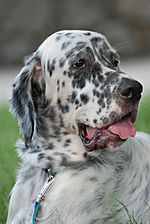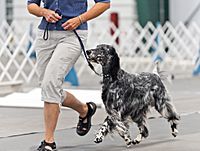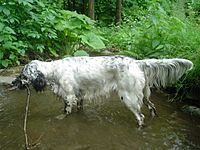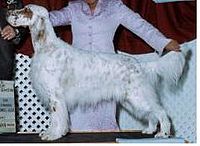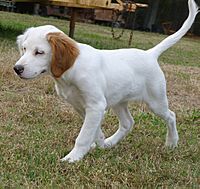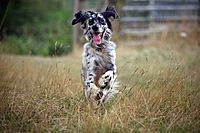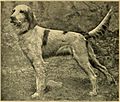English Setter facts for kids
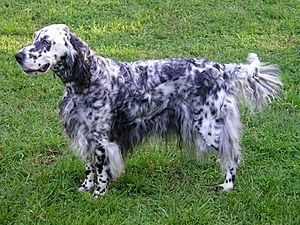
A blue belton English Setter
|
||||||||
| Other names | Lawerack Laverack Llewellin (or Llewellyn) Setter |
|||||||
|---|---|---|---|---|---|---|---|---|
| Origin | England | |||||||
|
||||||||
| Domestic dog (Canis lupus familiaris) | ||||||||
The English Setter is a medium-sized dog. It belongs to the setter family, like the red Irish Setter and the black-and-tan Gordon Setter. These dogs have a mostly white coat that is medium length. They also have long, silky fringes of fur on their legs, belly, and tail. Their coats have small spots of color, which are called "belton."
English Setters are gentle but can be a bit stubborn and playful. They are hunting dogs known for their strength and speed. They were bred to hunt birds like quail, pheasant, and grouse. When hunting, they use their excellent sense of smell to find prey. Sometimes, they are called Laverack or Llewellin Setters, named after famous breeders from the 1800s. Dogs bred for hunting often look leaner and have less fur than those bred for dog shows.
These dogs are generally healthy and usually live for 11 to 12 years. Dog clubs suggest checking them for hip problems.
About the English Setter
What English Setters Look Like
The English Setter is an elegant-looking dog. Females are about 61 cm (24 inches) tall, and males can be up to 69 cm (27 inches) tall. Dogs bred for hunting are usually slimmer than those bred for dog shows. These dogs were made to hunt birds, so they need to be able to run across large areas. They hold their heads high to sniff the air for birds.
Their heads are slightly rounded, with a deep muzzle. Their eyes are dark and have a kind, gentle look. Their ears, sometimes called "leathers," are set in line with their eyes and fold gracefully. They have strong, muscular necks and deep chests. Their bodies are a good length for their height, and their back legs are powerful. They carry their tails in line with their backs, and the tail should reach their hock (a joint in the back leg).
The main fur on their body is short to medium length, lies flat, and feels silky. Longer, silky fur, called "feathering," grows on their ears, neck, chest, legs, belly, and tail. This fur should be straight and flat, not too thick, and never curly, though a slight wave is okay. Show dogs have longer, flowing coats that need lots of brushing. Hunting dogs have shorter coats that are easier to care for.
The main color of their fur is white, with different colored spots or speckles. These spots are called belton. Common belton colors include:
- White with black spots (blue belton)
- White with orange spots (orange belton)
- White with orange spots and a lighter nose (lemon belton)
- White with liver-colored spots (liver belton)
- Tricolour, which is blue or liver belton with tan marks on the face, chest, and legs.
The spots should be spread all over the body, not in large patches. The word "belton" was first used by Laverack, who helped develop the breed. It's also the name of a village in northern England. Puppies might not have all their adult markings when they are born.
- English Setter
English Setter Temperament
English Setters are often described as "Gentlemen by Nature." However, they can also be strong-willed and playful, especially if they come from hunting lines. They are energetic dogs that love people. They are great for families who can give them lots of attention and activities. They also do well working with hunters.
These are active dogs that need plenty of exercise, often up to two hours a day. Indoors, they tend to be calm and enjoy relaxing on the couch or being lap dogs. They are known for being "intensely friendly," "good-natured," and "adore visitors and are particularly happy with children."
English Setters are very smart. They can be trained to do many tasks, but their natural hunting instinct can distract them outdoors. They are sensitive to criticism, so positive training methods using treats and praise work best.
English Setter Health
Like all dog breeds, English Setters can have some health issues. Some problems that can occur include:
- Deafness: Some English Setters can be born deaf. In 2010, a study found that about 12% of English Setters tested had some hearing loss.
- Thyroid problems: Conditions like autoimmune thyroiditis and hypothyroidism can affect them.
- Elbow dysplasia: This is a problem with the elbow joint.
- Allergies: They can have allergies to certain foods or skin conditions.
In the UK, The Kennel Club advises breeders to check for hip dysplasia in English Setters. This helps ensure healthier puppies.
Some English Setters may get cancer, especially after age ten. This was the most common cause of death in one survey, but the survey didn't get many responses. English Setters usually live between 11 and 12 years, but some can live to be 13 to 15 years old.
What English Setters Do
Setters hunt by covering large areas in a careful, quiet way, looking for game birds by scent. When they smell prey in the air, they freeze instead of chasing it. This "setting" or "pointing" stance is how they got their name. Once the dog shows where the birds are, it will slowly move forward to make the birds fly up.
In the past, hunters would then release hawks to catch the birds. Later, when nets were used, the hunter would throw a net over the birds. When guns became common in the 1600s, setters were still used to find and point to birds, but they also had to stay calm when a gun was fired.
Setters pick up the scent of birds from the air, not from the ground. Most setters are born with a natural desire to hunt. Dogs that show excitement around birds are called "birdy." Trainers look for this trait in puppies. Training often starts with quail or pigeons.
In 1876, Arnold Burges wrote that the "pure-blooded English Setter" was the best dog for hunting in American uplands.
English Setter History
The term "setting dogges" was used for setters a long time ago. The English Setter's first job was to "set" or point to upland game birds. It seems the English Setter has been a trained bird dog in England for over 400 years. Art from the early 1400s shows dogs that look like setters.
It's believed that the English Setter came from mixing the Spanish Pointer, large Water Spaniel, and English Springer Spaniel. This mix created an excellent bird dog that was good at finding and pointing game in open areas.
In 1576, Dr. Johannes Caius described a new dog from France that was "speckled all over with white and black, which mingled colours incline to a marble blewe." This might have been a description of the blue belton color seen in English Setters today. Caius also described the setter, calling it "Index" in Latin, meaning "pointer." He wrote that the dog would quietly follow its master, then freeze and lie down when it found a bird, showing the hunter where the bird was.
By the 1600s, setters were common on British estates. Over time, breeders started to separate the different colored dogs and breed them for specific hunting areas.
English Setters in Competitions
Field (hunting) type and show type English Setters look quite different, even though they are the same breed. Field setters are often smaller, with less feathering and more distinct spots. These traits help them in the field: less fur means fewer burs, and more spots make them easier to see.
English Setters are part of the gundog group in the UK and the Sporting group in America and Canada. In dog shows, it's rare for an English Setter to become a "Dual Champion," meaning it excels in both shows and field trials.
In the UK, a dog can earn different champion titles:
- Show Champion (Sh Ch): For winning three Challenge Certificates under different judges.
- Champion (Ch): For winning a Show Champion title plus a field trial award.
- Field Trial Champion (Ft Ch): For winning specific field trial competitions.
- Dual Champion: The highest award, for dogs that are both Show Champions and Field Trial Champions.
An English Setter named "Countess" was the first gundog to ever become a Dual Champion. She was bred by Laverack and later owned by Llewellin.
English Setters have won "Best in Show" at the famous Crufts dog show in the UK in 1964, 1977, and 1988. At the Westminster Kennel Club Dog Show in America, an English Setter won "Best in Show" in 1938. He was only 11 months old and it was his first show! He is the only setter to win Best in Show at Westminster since the award began in 1907.
English Setter Registrations
When the American Kennel Club (AKC) started in 1878, English Setters were among the first nine purebred dogs registered. The very first dog registered with the AKC, with registration number one, was an English Setter named "Adonis." He was born in 1875 and had black, white, and tan colors.
English Setters were very popular in the UK during the 1960s, 70s, and 80s. In 1974, 1,344 puppies were registered. However, their numbers have dropped. In 2012, The Kennel Club listed the English Setter as a "Vulnerable Native Breed" because only 234 puppies were registered. This number increased slightly to 314 in 2012, moving them to the "At Watch" list. But by 2015, registrations fell again to 289, putting them back on the "Vulnerable Native Breeds" list for 2016.
In Italy, the breed is still popular as a working gun-dog, but their numbers are also declining there. In contrast, the American Kennel Club reported that 2011 was the "year of the setters," with all four setter breeds gaining popularity. English Setters moved up from 101st to 87th most popular breed in America in 2011 and 2012.
Images for kids
See also
 In Spanish: Setter inglés para niños
In Spanish: Setter inglés para niños



